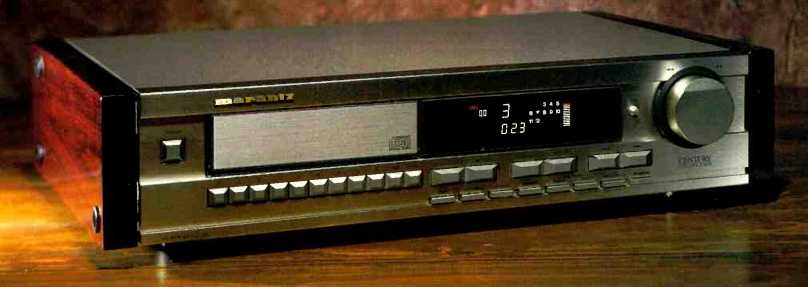
Manufacturer's Specifications
Frequency Response: 20 Hz to 20 kHz, ±0.5 dB.
THD: Less than 0.005% at 1 kHz.
S/N: Greater than 100 dB.
Dynamic Range: Greater than 96 dB.
Output Level: Normal, 2 V, variable; digital coaxial, 0.5 V peak to peak, ± 0.1 V.
Number of Programmable Selections: 20
Power Consumption: 120 V a.c., 60 Hz, 13 watts.
Dimensions: 16 15/16 in. W x 4 3/8 in. H x 12 7/8 in. D (43 cm x 11.1 cm x 32.6 cm).
Weight: 9.3 lbs. (4.2 kg).
Price: $450.
Company Address: 700 North Commerce St., Aurora, Ill. 60504, USA.
The Marantz CD3577 serves as a good illustration of how the much-discussed, one-bit D/A conversion system can be used to produce a superb-sounding CD player whose low level linearity rivals that of players costing several times this handsome unit's relatively modest price. Different manufacturers have come up with different names for the one-bit D/A conversion process. Marantz chooses to call their approach Class DX one-bit conversion. As Marantz describes the system, Class DX is intended to solve both low-level non-linearity and zero-crossing distortion (the error that occurs when signal polarities change). It does so by first increasing the sampling rate, with a digital filter, to 256 times the CD's sampling rate of 44.1 kHz. A computerized interpolator then changes the pulse code to pulse-width modulation by monitoring changes in value rather than discrete values of each digital word. Timing is quartz-controlled.
The pulse-width modulation (PWM) signal then goes through a low-pass filter that changes it to analog, continuous-waveform audio. All one-bit systems introduce higher residual noise levels than do conventional ladder-type D/A converters. Accordingly, a process known as noise-shaping is required. In the Marantz CD3577, third-order noise-shaping is used. This process moves the generated noise components up and out of the audible frequency range.
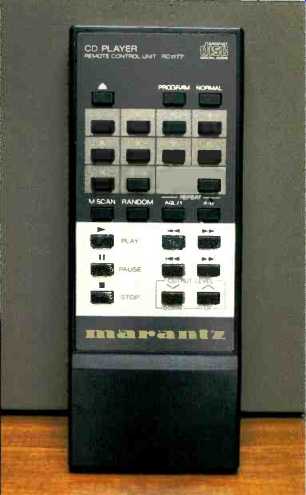
More apparent features of the CD3577 include a track "calendar" display, a fluorescent multi-function status monitor, four repeat play modes (track, complete disc, program, and A-B segments), 20-track programmability, random play, dual editing controls for programming and timing, and a coaxial digital output jack. A supplied 27-key infrared re mote control can access all major functions including adjustment of volume level.
The disc tray is configured to accept standard discs as well as the smaller, 3-inch singles without the use of an adaptor ring. The CD3577 is available in a brushed-gold or matte-black aluminum finish, and optional lacquered-rosewood side panels can be purchased if you want to dress up the unit even more. The sample I tested had a brushed-gold finish, and I must confess that, to my eyes at least, this is a refreshing change from the black front panels that have become standard for most audio components these days.
Control Layout
Attractively sculptured square and rectangular push buttons are used for powering up the CD3577, for selecting track numbers (for immediate play or during programming), for opening and closing the disc drawer, for skipping to tracks in either direction, and for the usual transport functions. At the extreme right of the panel is a large rotary knob that resembles a master volume control. In fact, this knob can be turned only a few degrees in either direction from its neutral point and is used for fast-searching through a disc in either direction. When I first examined this player, I was somewhat annoyed that there was no direct way to move from index point to index point within a track. I quickly discovered, however, that the fast-search knob serves just as well for this purpose, since it is easy enough to watch the display and stop at the desired points within a track. A tiny pushbutton near this knob alters the time-display mode (track elapsed time, remaining track time, total elapsed time, or total remaining time).
Smaller keys along the lower edge of the player handle such functions as random play, auto space (for insertion of a 4-S space between tracks during play), program checking and clearing, normal play (the default mode when power is applied), programming, and editing. The "Edit" key is used when you want to select and record all the tracks on a disc that can fit on a tape of designated length. During this mode of operation (which Marantz calls Compu Edit), the track advance and reverse keys can be used to enter any popular cassette length, while the large jog/shuttle knob normally used for fast-searching can be used to fine-tune the tape length in 1-minute increments.
The display area shows the current track number and elapsed or remaining time for the track or disc. Other indicators on the display show the status of such functions as programming, random play, auto spacing, Compu Edit, repeat play, output-level setting (by means of a bar graph), and the "music calendar" (for up to 20 tracks).
The supplied remote has most of the main control functions found on the front panel plus volume up/down buttons for controlling the player's output level. Because the default setting when power is first applied is maximum volume, users are cautioned to keep amplifier volume at a suitably moderate level.
Measurements
Frequency response of the Marantz CD3577, shown in Fig. 1, was within 0.15 dB from 10 Hz to 20 kHz. Output levels of both channels were within 0.1 dB of each other when output was adjusted for maximum.
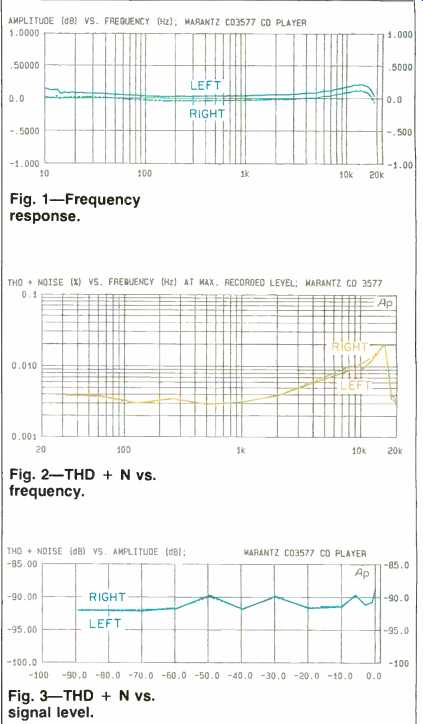
Fig. 1--Frequency response.
Fig. 2--THD + N vs. frequency.
Fig. 3--THD + N vs. signal level.
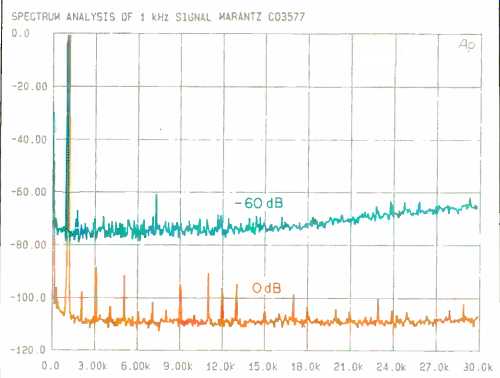
Fig. 4--Spectral analysis of 1-kHz signal at two recorded levels. Each curve
is averaged result of 16 acquisitions, to reduce displayed noise and improve
display of coherent signals.
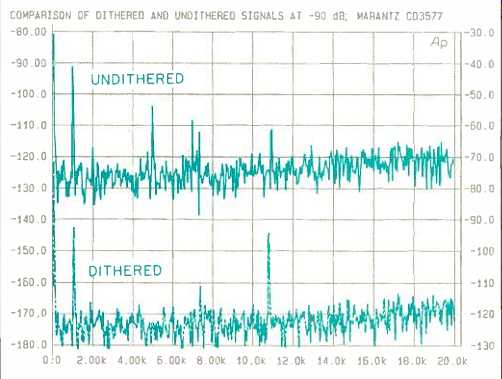
Fig. 5--Spectral analysis of 1-kHz signals recorded at-90 dB.

Fig. 6--Spectral analysis of residual noise for "no-signal" track
of CD-1 test disc.
Fig. 7--Separation vs. frequency.
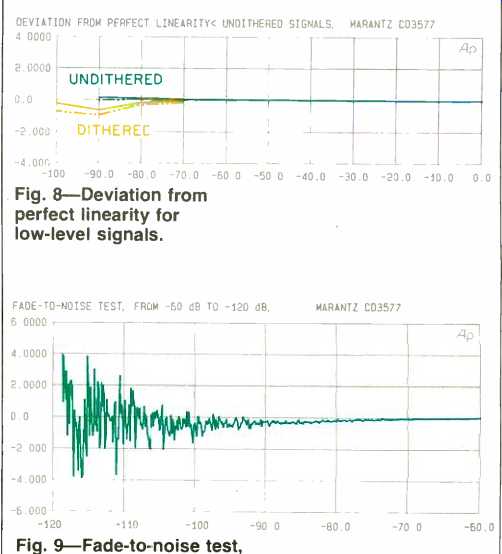
Fig. 8--Deviation from perfect linearity for low-level signals.
Fig. 9-Fade-to-noise test, using a gradually attenuated dithered signal.
Figure 2 shows how THD + N varied as a function of frequency during playback of signals recorded at maximum level. At mid-frequencies, distortion was approximately 0.003% and increased somewhat, to 0.02%, at 15 kHz.
Figure 3 shows how THD + N varied with recorded level from -90 dB to 0 dB (maximum level). All readings are in dB and referenced to maximum recorded level; they range from -89 dB at maximum recorded level to -92 dB at lower levels. Translating these readings to percentages of maximum output yields figures of 0.0035% to 0.0025%, pro viding good correlation with the results obtained in Fig. 2.
To determine the player's actual harmonic distortion (as opposed to distortion plus noise) when reproducing a 1-kHz test signal, I used the FFT spectrum analysis capability of my DSP-equipped Audio Precision System to plot the graphs shown in Fig. 4. For each of the two signal levels shown, 16 acquisitions of the signal were made to reduce random noise and to highlight only the actual harmonics of the desired signal. For a 1-kHz signal recorded at maximum level, the more significant (though very low-level) harmonics can be seen at 3, 5, 9, 11, and 13 kHz; each is more than 90 dB below maximum recorded level. For a 1-kHz signal recorded at-60 dB, "0.0" dB in the graph represents the level of the test signal. Even at this low level, the only significant harmonic component that can be observed (at 7 or 8 kHz) is 60 dB lower than the test signal itself, or actually 120 dB below maximum recorded level. This shows that the harmonics seen in the curve for the 0-dB signal were more than likely generated by the player's analog audio stages rather than by any of its digital circuitry.
Figure 5 shows how low-level signal recovery can be improved by proper use of dither during the recording process. Both curves represent spectrum analysis of signals recorded at 90 dB below maximum record level. With undithered signals, a substantial fifth-harmonic component of the 1-kHz test signal is quite prominent (only about 14 dB lower in amplitude than the desired 1-kHz signal itself). With dithered signals, that spike has all but disappeared, as have the spikes from harmonics of lower order. Overall noise levels increased very slightly for the dithered signal, but hardly enough to negate the advantages of dithering. I have no immediate explanation for the increase in amplitude of the 11-kHz component in the curve made using dithered signals, but I seriously doubt if it could be heard at its level of about-95 dB.
A-weighted S/N ratio of the Marantz CD3577 was 99.7 dB for the left channel and 99.2 dB for the right. Figure 6 shows how noise level varied with frequency when I used a 1/3-octave swept-band pass filter to "track" the noise. There was no significant contribution to overall noise at the power-line frequency or its harmonics.
Separation, plotted in Fig. 7, measured 95.5 dB at 1 kHz for both channels. At 16 kHz, it decreased to 91.5 dB for the right channel and 80.7 dB for the left.
A spot reading of SMPTE-IM distortion was made for a test signal recorded at maximum amplitude, and the result was 0.0096% for either channel. Frequency, or "clock," accuracy was also checked and found to be +0.0032% of perfect.
The advantages of Marantz's one-bit D/A conversion system were immediately apparent when I measured deviation from perfect linearity (Fig. 8). Whether for undithered signals from 0 to -90 dB or dithered signals from -70 to -100 dB, deviation from perfect linearity was about as low as I have ever seen for any CD player, regardless of price. I am not saying that superb linearity is not obtainable with other D/A conversion techniques. However, the relatively moderate price of the CD3577 confirms the claim that achieving such excellent low-level linearity is less costly when a one-bit D/A conversion system is employed.
The fade-to-noise test, using dithered signals from 60 to 120 dB below maximum recorded level, showed equally impressive low-level linearity. The results (shown in Fig. 9) also enabled me to establish the EIA dynamic range for this unit, which was approximately 110 dB. Using the EIAJ method, dynamic range was exactly 90 dB.
Use and Listening Tests
I found all controls of the CD3577 to be easy to use and understand. The search knob provided fast access to specific points on a disc yet was sensitive enough so that I could stop at almost precisely the point I wanted in any musical or test disc.
The one disappointment occurred when I subjected the player to my usual error-correction and tracking tests. Using the special Pierre Verany test disc that has areas of measurable data obliteration, I was somewhat surprised to find that the player began to mistrack when it encountered opaque tracks of only 1 mm in length. Now, I realize that in the early days of CD, I waxed enthusiastic over players that could ignore missing data extending to 0.7 mm. Still, recent players have generally been able to do much better than this, sailing through missing data that was 1.5, 2.0, and in some cases even 3 mm in length. It is possible that only my sample exhibits this limited tracking ability, but I have no way to confirm it. If you are interested in this otherwise superb player, I suggest that you give the unit a less-than-gentle tap on its top and sides to check for mistracking, muting, or other sonic glitches. Playing a disc that you know has some minor surface scratches is another good test for trackability.
As for the Marantz's musical reproduction of discs, I have nothing but praise. Audition this player using solo instrument recordings, piano recordings, or vocals. Listen, particularly, for low-level passages and then compare the clarity of sound you hear from the CD3577 with that of similarly priced players which have conventional ladder or parallel-type D/A converters. I'll venture a guess that you will hear the same differences that I did when I listened to the Marantz versus an early player that I still own (but that has been relegated to a secondary system, far from my lab and its reference-grade components). A few selections that may serve to prove the point are track 6 of a Delos recording (DE 3064) featuring, among other Franz Joseph Haydn works, his Piano Concerto No. 5 in G Major, with soloist Carol Rosenberger, and tracks 11 and 16 of another Delos disc, Romantic Cello Favorites (DE 3065). For an evaluation of vocal reproduction accuracy, I listened to tracks 8 and 11 of a Telarc disc (CD-80194) featuring vocal religious works by Vivaldi (Gloria in D Major) and J. S. Bach (Magnificat in D Major). These other discs confirmed my belief that it is now possible to obtain superb musical reproduction from a CD player that is both modestly priced and handsomely styled.
Marantz classifies the CD3577 as part of their Century Collection, a group of audio components which, in their words, "demonstrate the Marantz commitment to the art and science of audio-art on the outside and state-of-the-art on the inside." I couldn't agree more.
-Leonard Feldman
(Source: Audio magazine, Dec. 1990 )
Also see: link
Marantz CD-17 CD Player (Feb. 1997)
Marantz CD-94 CD Player and CDA-94 D/A Converter (Equip. Profile, Aug. 1988)
Marantz CDR-1 Professional CD Recorder (Apr. 1992)
Philips CD960 Compact Disc Player (Jun. 1988)
Philips CD880 Compact Disc Player (Jan. 1989)
Philips LHH 500 CD Player (Apr. 1992)
Philips LHH1000 compact disc playback system (Jan. 1990)
Mod Squad Prism Compact Disc Player (Aug. 1988)
link --Magnavox CDB650 CD player (Mar. 1987)
= = = =